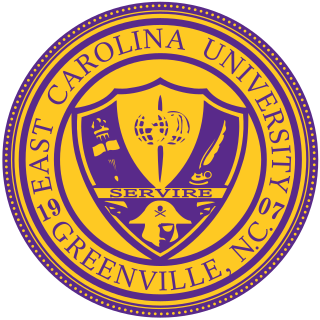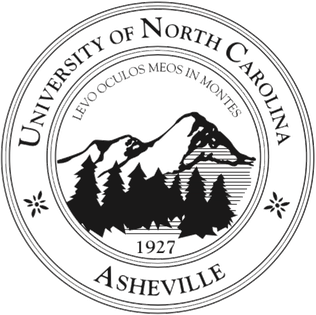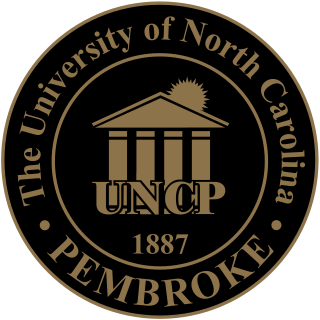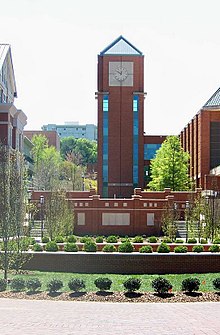
North Carolina State University is a public land-grant research university in Raleigh, North Carolina, United States. Founded in 1887 and part of the University of North Carolina system, it is the largest university in the Carolinas. The university forms one of the corners of the Research Triangle together with Duke University in Durham and the University of North Carolina at Chapel Hill. It is classified among "R1: Doctoral Universities – Very high research activity".

East Carolina University (ECU) is a public research university in Greenville, North Carolina. It is the fourth largest university in North Carolina and the only one in the state with both a medical school and a dental school.

The University of North Carolina at Chapel Hill is a public research university in Chapel Hill, North Carolina. Chartered in 1789, the university first began enrolling students in 1795, making it one of the oldest public universities in the United States.

The University of North Carolina at Asheville is a public liberal arts university in Asheville, North Carolina, United States. UNC Asheville is the designated liberal arts institution in the University of North Carolina system. It is a member and the headquarters of the Council of Public Liberal Arts Colleges.

Western Carolina University (WCU) is a public university in Cullowhee, North Carolina. It is part of the University of North Carolina system.

The University of North Carolina at Pembroke is a public university in Pembroke, North Carolina. UNC Pembroke is a master's level degree-granting university and part of the University of North Carolina system. Its history is intertwined with that of the Lumbee nation.

The University of North Carolina at Charlotte is a public research university in Charlotte, North Carolina. UNC Charlotte offers 24 doctoral, 66 master's, and 79 bachelor's degree programs through nine colleges. It is classified among "R2: Doctoral Universities – High research activity".

North Carolina Agricultural and Technical State University is a public, historically black, land-grant research university in Greensboro, North Carolina. It is a constituent institution of the University of North Carolina System. Founded by the North Carolina General Assembly on March 9, 1891, as the Agricultural and Mechanical College for the Colored Race, it was the second college established under the provisions of the Morrill Act of 1890, as well as the first for people of color in the State of North Carolina. Initially, the college offered instruction in agriculture, English, horticulture and mathematics. In 1967, the college was designated a Regional University by the North Carolina General Assembly and renamed North Carolina Agricultural and Technical State University.
The Carnegie Classification of Institutions of Higher Education, or simply the Carnegie Classification, is a framework for classifying colleges and universities in the United States. It was created in 1970 by the Carnegie Foundation for the Advancement of Teaching. It is managed by the American Council on Education.

The North Carolina Tar Heels Men's basketball program is a college basketball team of the University of North Carolina at Chapel Hill. The Tar Heels have won six NCAA championships in addition to a 1924 Helms Athletic Foundation title (retroactive). North Carolina has won a record 133 NCAA tournament matchups while advancing to 31 Sweet Sixteen berths, a record 21 Final Fours, and 12 title games. It is the only school to have an active streak of reaching the National Championship game for nine straight decades and at least two Final Fours for six straight decades, all while averaging more wins per season played (20.7) than any other program in college basketball. In 2012, ESPN ranked North Carolina No. 1 on its list of the 50 most successful programs of the past fifty years.
Herbert Holden Thorp is an American chemist, professor and entrepreneur. He is a professor of chemistry at George Washington University. He was the tenth chancellor of the University of North Carolina at Chapel Hill, assuming the position on July 1, 2008, succeeding James Moeser, and, at age 43, was noted as being among the youngest leaders of a university in the United States. At the time of his selection as chancellor, Thorp was the dean of the College of Arts and Sciences and a Kenan Professor of chemistry at the university. Thorp is a 1986 graduate of UNC; he later earned a Ph.D. in chemistry from California Institute of Technology, and was a postdoctoral associate at Yale University.

Conference Carolinas, formerly known as the Carolinas-Virginia Athletic Conference (CVAC) or the Carolinas Conference, is a college athletic conference affiliated with the National Collegiate Athletic Association (NCAA) primarily at the Division II level. It is also considered as one of the seven Division I conferences for men's volleyball. Originally formed in 1930, the league reached its modern incarnation in 1994. Member institutions are located in the southeastern United States in the states of Georgia, North Carolina, South Carolina, and Tennessee. The Conference Carolinas membership currently consists of 14 small colleges or universities, 12 private and two public.

The University of North Carolina at Chapel Hill is a coeducational public research university located in Chapel Hill, North Carolina, United States. It is one of three schools to claim the title of the oldest public university in the United States. The first public institution of higher education in North Carolina, the school opened on February 12, 1795.
The UNC Pembroke Braves football team represents the University of North Carolina at Pembroke in college football, competing in the Mountain East Conference. Pembroke plays its home games at the 4,000 seat Grace P. Johnson Stadium at Lumbee Guaranty Bank Field, which is located on-campus in Pembroke, North Carolina. Although only fielding a modern team since the 2007 season, Pembroke previously fielded teams between the 1946 and 1950 seasons as Pembroke State.

The UNC Pembroke Braves are the athletic teams that represent the University of North Carolina at Pembroke, located in Pembroke, North Carolina, in NCAA Division II intercollegiate sports.
Ruth Dial Woods was an American educator and activist. A member of the Lumbee Tribe of North Carolina, she was the first woman to serve as the associate superintendent of the Robeson County Public Schools and to receive an at-large appointment to the University of North Carolina Board of Governors. After teaching in the public school system of Robeson County for 27 years, she joined the faculty at Fayetteville State University. In addition to her work as an educator, Woods was involved in the Civil Rights Movement, the Women's liberation movement, and the American Indian Movement. She has served as a community development consultant for the United States Department of Labor and as a consultant for the Lumbee Tribal Council for administration of tribal programs. The recipient of numerous awards and honors for her work in human rights and education, in 2011, she was inducted into the North Carolina Women's Hall of Fame.

 Durham – NC Central and NCSSM
Durham – NC Central and NCSSM  Greensboro – UNC Greensboro and NC A&T
Greensboro – UNC Greensboro and NC A&T  Winston-Salem – WSSU and UNCSA
Winston-Salem – WSSU and UNCSA 














